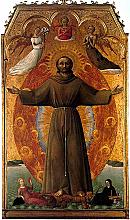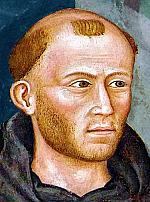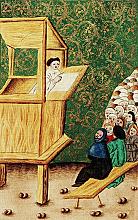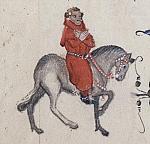“Repair my house”
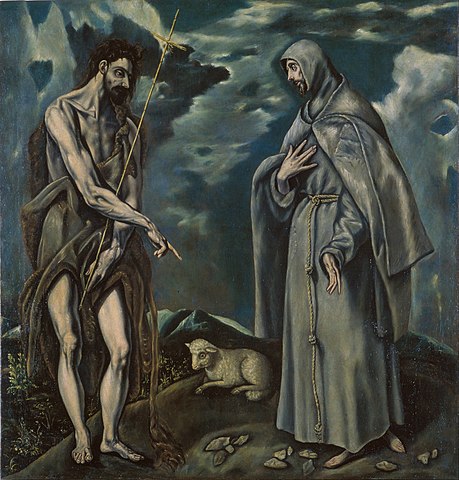
[Workshop of El Greco, Saint John the Baptist and Saint Francis of Assisi, Oil on Canvas, c. 1600—Museu Nacional d’Art de Catalunya / Public domain, Wikimedia File:Workshop of El Greco - Saint John the Baptist and Saint Francis of Assisi - Google Art Project.jpg]
He began life as Francesco Bernardone in the little town of Assisi, 90 miles north of Rome. We know him as Francis of Assisi (1181–1226). His path from one name to the other would profoundly alter Christendom. Born in 1181 he grew up in what we would call an upper-middle-class home. His father traveled back and forth to northern France for his business as a successful cloth merchant. Francis helped in his father’s shop and occasionally traveled abroad with him as a boy.
Restless and unsure of what else to do, 21-year-old Francis went off to war against Perugia, as all young men were supposed to do to defend their city, only to end up a prisoner. When he was released, his father purchased for him the very best armor. Two years later he set off to battle once more, dreaming of renown, but returned almost immediately, making it only as far as Spoleto, where he saw a vision. Francis proved to be either inept at soldiering, a deserter, or both. He would see other visions that prompted a different calling and turned his thoughts from worldly aims to spiritual.
Francis struggled with intense and disparate emotions during the early years of his conversion, soaring to heights of exceeding joy at one moment while sinking into morose, brooding depths in the next. Bonaventure (1221–1274)—the early Franciscan theologian who wrote the authorized biography of Francis—says the sensitive young man “sought lonely places, dear only to mourners.”
He sometimes frequented the dark caves upon Mount Subasio, which had given its pink-colored stone to construct many of Assisi’s churches and other buildings. In these quiet places, loving solitude for the first time, Francis repented of his sins of pride, luxury, and selfishness.
Then he returned to Assisi and repented again in very public fashion. In this small town, where everyone knew one another, such a display only served to embarrass his respectable father. Francis also stole from him—expensive silken materials, easily sold for coin—to give money to the poor. The good priest to whom he gifted it would not accept it.
Bernardone found out and imprisoned Francis in the basement of the family home, hoping his son would snap out of it and grow up. Soon thereafter, when Bernardone left on business, Francis’s mother (about whom we know precious little) freed the young man. Francis fled to San Damiano, the somewhat remote and abandoned church he had grown to love. There the most famous scene in his life took place.
“Rebuild my church”
San Damiano was probably tended by a priest, but a poor or absent-minded one. The building had fallen into the beginning stages of ruin, but its pitiful state had drawn Francis to it in the first place. The altar appealed to him, and the icon that hung above it; that icon of Christ on the cross was one of the most striking in all of Umbria.
Francis looked into the eyes of Christ there, feeling absolutely sure that they were the eyes of God looking back at him. He looked at icons as medieval people did; he wandered down to San Damiano so often because he wanted to be seen by Christ. Kneeling in the church alone that day in 1205, Francis heard the voice of God telling him, “Go and rebuild my church.” The word of God, a word spoken directly to his heart, pointed to a direction for his life.
When Francis returned to Assisi from the abandoned church having just heard the voice of God, he had no one to whom he could tell this story. Bonaventure said, “The servant of the Most High had no one to instruct him except Christ.” But later he would expand on what Christ said to him, telling his first companions what he heard: “Francis, go and repair my house, which, as you can see, is falling down.” Immediately he set out on his first mission: to gather stones and repair the fallen chapel. He was a simple man who lived in the present and valued direct action.
Francis became a mendicant as well, a deliberately poor wandering preacher of salvation. Slowly but surely, and almost by accident, he started gathering followers. People wanted to know what was happening to Bernardone’s son and why he was changing so obviously and dramatically. When someone inquired how they might do what Francis was doing, Francis replied that they must first sell everything they owned and give the money to the poor.
Though he lived out this conviction daily, his most public opportunity to prove it arrived in the form of his father. In Assisi’s town square, Bernardone confronted Francis. The two stood together before the local bishop, who was acting as judge, so that Francis could face his father’s accusations of stealing and insolence.
Bernardone insisted on receiving respect from his son, as every father is due, but Francis stripped himself of every last bit of fine clothing, laid them at his father’s feet, and declared that he now had only a Father in heaven. With this Francis renounced all the privilege, honor, and wealth that came with the name Bernardone, taking on instead the poverty befitting one who must give all for Christ.
Friars without borders
Francis spent the rest of his life sharing this vision and ministering to others. He focused on preaching the good news to people in the simplest of terms, explaining to them how they could find more joy in their lives if they too lived in poverty. He helped the sick, caring even for lepers, who were cast out of the community and forbidden to come in contact with other people. Francis would wash their bodies and spend time with them, having overcome his own earlier feelings of repulsion toward them.
The Legend of the Three Companions—written by Francis’s friends Angelo, Leo, and Rufino between 1241 and 1247, almost 20 years before Bonaventure’s official biography—tells us that the moment before the cross of San Damiano initiated Francis’s identification with Christ, and in particular, with Christ’s Passion. This would later culminate in the mystical event of receiving stigmata on a mountaintop during a particularly intense Lenten retreat. Francis’s reception of these marks, resembling the marks on Christ’s crucified body, is the first such event recorded in history.
When Francis received his word from God at San Damiano, he did not run off and join a monastic order—an important piece of information. Becoming a monk with the Benedictines or the Cistercians would have been the most logical thing for a young man to do in these circumstances. But Francis looked upon joining these institutions as different from what he was called to fix and to do. Instead he began his work in the reforming mendicant tradition.
As Francis left San Damiano, he already had his mission in mind and plunged his hands in both pockets to give every coin to the attendant priest nearby. His religious order would eschew monastery walls. His friars would live without permanent houses of their own, walking from place to place, wherever they were needed. Not only was this central to Francis’s interpretation of God’s will for his life, he also found freedom and joy in such living.
From 11 to 30,000
In the spring of 1209, Francis, now with 11 companions, walked to Rome to ask Pope Innocent III (1161–1216) for a blessing. Over the next 15 years, Francis traveled to Dalmatia, Spain, France, Acre, and Damietta, Egypt, where he later famously met with the sultan. By this time he led a religious movement of both men and women, numbering in the thousands. Clare of Assisi (no relation), the first woman to join, did so rather suddenly on Palm Sunday in 1212; she soon came alongside permanently, taking vows like the men. Francis and Clare cofounded what is most often called the “Poor Clares” today—women living by vows similar to male Franciscans, surrounding Clare in the refurbished San Damiano.
Charity and compassion marked the lives of Francis, Clare, and all the first Franciscans, but they did not seek the sort of work done by large organizations. Such movements often became merely career paths for social advancement and power in the church, which the Franciscans resisted. They wanted only simple and joyful men and women living by those seemingly impossible-to-follow instructions of Jesus in the Gospels—not thinking about tomorrow, but living for today. Believing themselves called to a life of following Christ, they cut away anything that stood in the way.
They were not as interested in changing institutions as they were in impacting individual lives. They cared for people’s needs immediately rather than in the long-term. Ironically their movement grew more rapidly than any religious order had before. By 1250 it numbered about 30,000. Hundreds of Franciscan friaries existed within a decade of Francis’s death and a thousand by 1275.
In the year 1220 or 1221, Francis resigned as spiritual leader of the religious order he had founded, and another friar was appointed vicar. By the end of his life, Francis watched with a measure of sadness as the order grew beyond the boundaries of his original, most simple, intentions. Houses were built. Young friars were sent off to theological schools. Closer ecclesiastical supervision was welcomed, as the Franciscans became just another religious order within the Roman Catholic Church.
Even before his death on the night of October 3, 1226, most already considered Francis a saint. As he was dying, people tried to pilfer pieces of his clothing. They literally wanted a piece of him because, in their worldview, proximity to a saint meant a little more holiness in one’s life. For the last century, he has been the world’s most popular saint in churches, books, paintings, sculpture, and every other imaginable representation. It took nearly 700 years for a pope to take his name, so presumptuous it seemed to onlookers that anyone could imitate him.
“God’s jugglers”
Curiously we rarely see Francis smile in paintings and sculptures—an unfortunate omission, for, according to his biographers, he was one of the most joyous of people. He was the leader of a band of brethren calling themselves “God’s jugglers” as they worked, played, sweated, and laughed with men in fields and towns before ever preaching to them.
This sunny disposition also showed itself in how Francis located God in some startlingly new places according to the thirteenth-century worldview: not just in church, or in people trying to be faithful, but in lepers and outcasts, in ravenous wolves, in fish and birds, in the sun and the moon, even in bodily pain and death. This was a man who rolled in the snow; who stripped naked to demonstrate to his father how joyfully he had renounced owning things; and who even preached in his underwear to show humility.
Historians of Italian literature often note Francis as the first Italian poet for his now-famous “Canticle of the Creatures” written in 1225. Francis composed this song in the Umbrian dialect of vernacular Italian when he was nearly blind, one year before his death, living in a small hut outside the walls of San Damiano in a place that Clare had prepared for him among the gardens. In it he expressed his wonder and belief in the wildness and expectancies of nature as part of God’s plan for human life. One of its verses runs:
Praise be to You, my Lord, for Mother Earth,
who sustains us and keeps us,
and brings forth the grass and all
of the fruits and flowers of many colors.
It was in honor of this song that Pope Francis wrote his encyclical, Laudato si’, in 2015. Describing his namesake he wrote, “He was particularly concerned for God’s creation and for the poor and outcast. He loved, and was deeply loved for his joy, his generous self-giving, his openheartedness. He was a mystic and a pilgrim who lived in simplicity and in wonderful harmony with God, with others, with nature and with himself.” CH
By Jon M. Sweeney
[Christian History originally published this article in Christian History Issue #149 in 2023]
Jon M. Sweeney is the author of many books, including Feed the Wolf, a work of Franciscan spirituality, and The Complete Francis of Assisi, used by Third Order Franciscans worldwide.Next articles
Walking in the way of St. Francis
Recommendations for reform from the traveling preacher
Francis of AssisiWinds of spiritual renewal
Mystics looked inward to revive and renew the love of christ
Glenn E. MyersFirst, preach Christ’s gospel
Many medieval preachers intended their sermons to renew and revive
Beth Allison BarrSupport us
Christian History Institute (CHI) is a non-profit Pennsylvania corporation founded in 1982. Your donations support the continuation of this ministry
Donate



